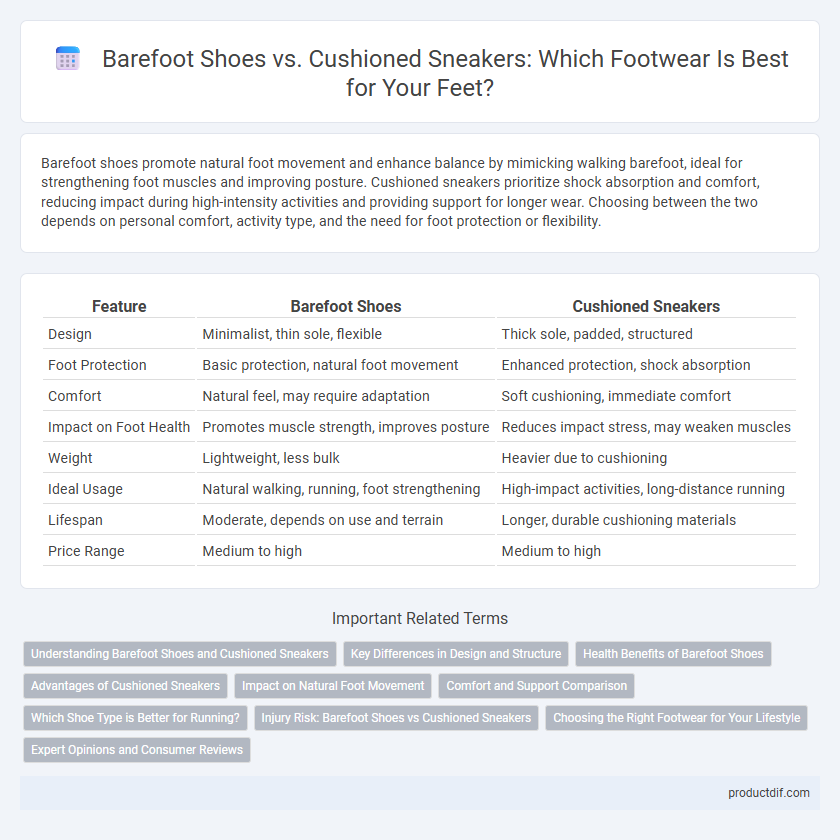Barefoot shoes promote natural foot movement and enhance balance by mimicking walking barefoot, ideal for strengthening foot muscles and improving posture. Cushioned sneakers prioritize shock absorption and comfort, reducing impact during high-intensity activities and providing support for longer wear. Choosing between the two depends on personal comfort, activity type, and the need for foot protection or flexibility.
Table of Comparison
| Feature | Barefoot Shoes | Cushioned Sneakers |
|---|---|---|
| Design | Minimalist, thin sole, flexible | Thick sole, padded, structured |
| Foot Protection | Basic protection, natural foot movement | Enhanced protection, shock absorption |
| Comfort | Natural feel, may require adaptation | Soft cushioning, immediate comfort |
| Impact on Foot Health | Promotes muscle strength, improves posture | Reduces impact stress, may weaken muscles |
| Weight | Lightweight, less bulk | Heavier due to cushioning |
| Ideal Usage | Natural walking, running, foot strengthening | High-impact activities, long-distance running |
| Lifespan | Moderate, depends on use and terrain | Longer, durable cushioning materials |
| Price Range | Medium to high | Medium to high |
Understanding Barefoot Shoes and Cushioned Sneakers
Barefoot shoes are designed to mimic natural foot movement by providing minimal cushioning and a thin, flexible sole that enhances ground feel and promotes foot muscle strength. Cushioned sneakers feature thick soles with ample padding to absorb shock and offer maximum comfort during high-impact activities. Understanding the differences in sole structure, flexibility, and foot support is essential for choosing between barefoot shoes and cushioned sneakers based on activity type and foot health needs.
Key Differences in Design and Structure
Barefoot shoes feature a minimalistic design with thin, flexible soles that allow natural foot movement and ground feel, promoting improved balance and posture. Cushioned sneakers incorporate thick midsoles with enhanced padding and arch support, designed to absorb shock and provide comfort during high-impact activities. The structural difference lies in barefoot shoes emphasizing foot biomechanics, while cushioned sneakers focus on impact protection and prolonged comfort.
Health Benefits of Barefoot Shoes
Barefoot shoes promote natural foot mechanics by allowing toes to spread and muscles to engage, which enhances balance and stability while reducing the risk of foot deformities. They encourage a forefoot or midfoot strike pattern, decreasing impact forces on joints compared to cushioned sneakers, which often encourage heel striking and contribute to repetitive stress injuries. Studies show barefoot shoes improve proprioception and strengthen intrinsic foot muscles, leading to long-term foot health and decreased incidence of plantar fasciitis and other common foot ailments.
Advantages of Cushioned Sneakers
Cushioned sneakers provide enhanced shock absorption, reducing impact on joints during high-intensity activities, which supports injury prevention and prolonged comfort. Advanced midsole materials like EVA and memory foam offer superior arch support and pressure distribution, benefiting individuals with foot pronation or plantar fasciitis. Their versatile design combined with durable outsoles ensures reliable traction and protection across diverse terrains and weather conditions.
Impact on Natural Foot Movement
Barefoot shoes promote natural foot movement by allowing toes to spread and providing minimal interference with gait mechanics, enhancing proprioception and foot muscle strength. Cushioned sneakers often restrict foot flexibility and alter natural walking patterns due to elevated heels and thick soles, which can reduce sensory feedback and weaken intrinsic foot muscles over time. Studies indicate that barefoot footwear supports a more biomechanically efficient stride, reducing impact forces and promoting healthier foot function.
Comfort and Support Comparison
Barefoot shoes prioritize natural foot movement with minimal cushioning, offering enhanced ground feedback and promoting better posture and muscle engagement. Cushioned sneakers provide substantial padding and arch support, which can reduce impact forces and enhance comfort for prolonged activities or high-impact sports. Choosing between barefoot shoes and cushioned sneakers depends on individual foot biomechanics, activity type, and preference for either natural motion or enhanced shock absorption.
Which Shoe Type is Better for Running?
Barefoot shoes promote natural foot movement and strengthen muscles by mimicking running barefoot, which may improve balance and agility during runs. Cushioned sneakers offer enhanced shock absorption and support, reducing impact on joints and lowering injury risk, especially on hard surfaces. Choosing the better shoe type depends on running style, surface, and individual biomechanics, with barefoot shoes suited for minimalists and cushioned sneakers favored by those prioritizing comfort and protection.
Injury Risk: Barefoot Shoes vs Cushioned Sneakers
Barefoot shoes promote natural foot mechanics by allowing greater flexibility and ground feel, which can reduce the risk of certain repetitive strain injuries linked to improper gait. Cushioned sneakers provide extra shock absorption and arch support, potentially lowering the impact forces on joints but may encourage unnatural foot posture, increasing injury risk like plantar fasciitis or Achilles tendonitis. Injury risk varies based on individual biomechanics, running surface, and adaptation period, making a gradual transition essential when switching between barefoot shoes and cushioned sneakers.
Choosing the Right Footwear for Your Lifestyle
Choosing barefoot shoes promotes natural foot movement and strengthens foot muscles, making them ideal for minimalist runners and those prioritizing proprioception. Cushioned sneakers provide enhanced shock absorption and support, suited for high-impact activities and individuals seeking extra comfort during extended wear. Assess your daily activities, foot mechanics, and comfort needs to select footwear that aligns with your lifestyle and performance goals.
Expert Opinions and Consumer Reviews
Experts emphasize that barefoot shoes promote natural foot mechanics and enhance proprioception, while cushioned sneakers offer superior shock absorption and comfort for high-impact activities. Consumer reviews reveal that barefoot shoes are praised for improving foot strength and posture but may require an adaptation period, whereas cushioned sneakers receive high marks for support and injury prevention during prolonged workouts. Both footwear types address different needs, with choice often depending on individual biomechanics and activity level.
Barefoot shoes vs Cushioned sneakers Infographic

 productdif.com
productdif.com